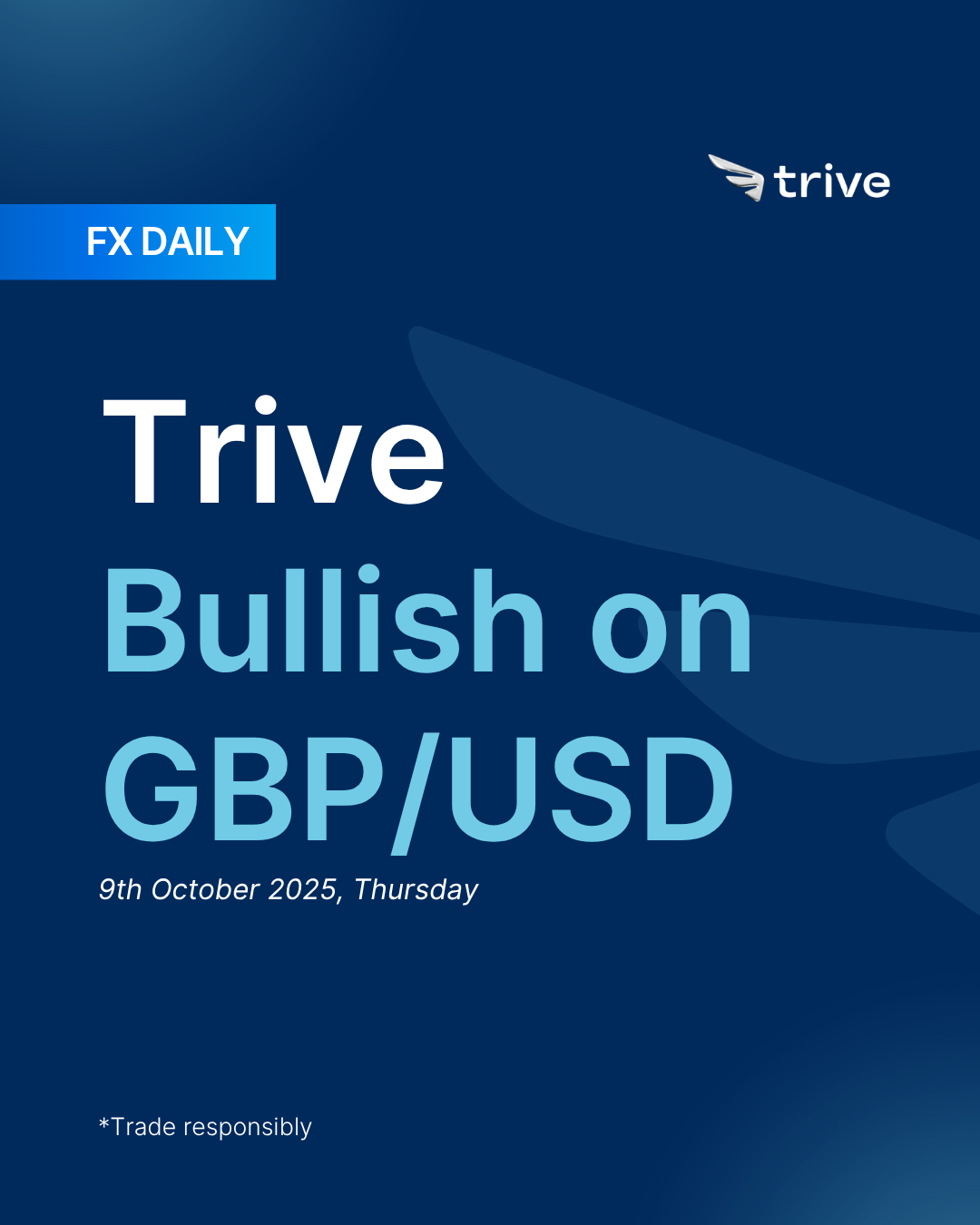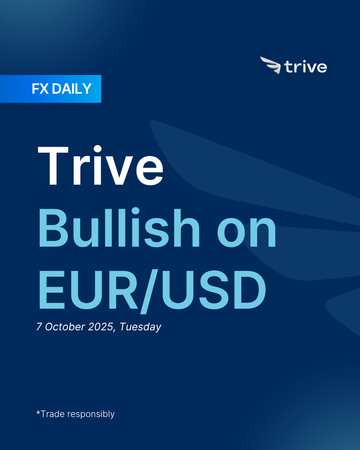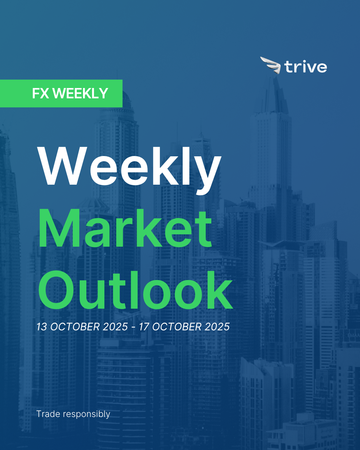FX Daily: Trive Bullish on GBP/USD

Sterling topped 1.3500 on broad USD weakness, but domestic data remain soft. Sticky inflation and hawkish BoE voices support “higher for longer,” though growth headwinds and fiscal risks cap upside. Near term, dollar weakness lifts GBP, but structurally the currency stays constrained, leaving gains fragile once Fed easing advances.
GBP: Short term strength
The British Pound had a volatile but ultimately positive week, lifted mainly by the broad US Dollar sell-off that pushed GBP/USD above 1.3500 for the first time in over a week. With little domestic data to guide trading, price action was largely shaped by external developments, particularly the US government shutdown and the surprisingly weak ADP employment report that triggered a wave of dollar selling. Within the UK, attention was split between continued hawkish signals from Bank of England officials and growing focus on the Labour Party’s fiscal plans ahead of a potential change in government. While hawkish remarks from MPC member Catherine Mann helped Sterling break above its 50-day moving average mid-week, gains proved temporary, and the pair faded from its highs before the weekend. The Pound ultimately ended the week stronger, but its performance remained mostly tied to shifts in the US narrative rather than domestic momentum.
Economic data from the UK offered little encouragement. Final September PMI readings showed a stagnant economy, with manufacturing remaining in contraction at 46.2 and services revised down to 50.8. The composite figure of 50.1 indicated the private sector was barely expanding by the end of the third quarter. Inflation concerns persisted, with the British Retail Consortium reporting that shop price inflation rose to 1.4 percent in September from 0.9 percent the month before. The Bank of England’s Decision Maker Panel survey also revealed that firms’ year-ahead CPI expectations increased to 3.4 percent, while wage growth expectations stayed elevated at 3.6 percent. The final estimate of second-quarter GDP was left unchanged at 0.3 percent quarter-on-quarter.
The policy backdrop was dominated by hawkish rhetoric from the Bank of England. Catherine Mann said that “the inflation persistence scenario is playing out” and argued that monetary policy remains “relatively loose.” Deputy Governor Ramsden added that there is still “scope for additional removal of policy restraint,” and newcomer Lombardelli expressed caution about inflation risks. Governor Bailey’s remarks on Friday added little new insight, and overall, market expectations were unchanged. Investors still do not fully price in a 25-basis-point rate cut until April 2026, signaling that the BoE remains firmly in a “higher for longer” stance rather than preparing for fresh tightening.
On the political front, the focus turned to the Labour Party’s annual conference, where Shadow Chancellor Rachel Reeves emphasized fiscal stability and promised to adhere to strict fiscal rules while ruling out tax increases on VAT, income, or national insurance. Attention also remained on the upcoming Autumn Budget, scheduled for November 26th, with reports suggesting that Labour may lift the two-child benefit cap, underscoring the fiscal pressures any incoming government will face.
Overall, Sterling’s gains this week were largely imported from abroad. The Pound moved in step with the global “sell dollar” theme, while domestic fundamentals continued to show sluggish growth, sticky inflation, and political uncertainty ahead of next month’s fiscal announcements.
Sterling bounced alongside the broad dollar sell off, briefly breaking above recent ranges before easing into the weekend. Our outlook is near term neutral with a bullish skew, as the move was driven more by external dollar weakness than new domestic momentum, yet firm BoE rhetoric and contained gilt spreads continue to support the pound’s tone.
Near term neutral with a bullish skew. We maintain a neutral stance but with a slight upside tilt, as domestic policy remains restrictive and front end yields still price a higher for longer path. Services PMI remains just above 50, inflation expectations are sticky, and hawkish remarks from Mann and Ramsden reinforce that the BoE is in no rush to ease. While the latest data show limited growth momentum, the combination of steady policy guidance, resilient wage expectations, and calm markets provides a mild cushion. The pound can benefit further if US data continue to disappoint or if risk sentiment stays constructive. We would turn more bullish if wages and services inflation firm again and gilt spreads remain stable, but any renewed fiscal concerns or a hawkish Fed tone would quickly cap gains.
Longer term weak bearish. We keep a mild downside bias over the medium horizon as structural headwinds, weak productivity, an external deficit, and fiscal uncertainty limit Sterling’s longer term appeal once the Fed begins to ease. The near term policy premium helps, but the UK’s slower growth trajectory and persistent fiscal risks continue to weigh on the outlook. The balance could shift if incoming data show sustained strength in PMIs, wages, and services inflation, paired with stable gilt dynamics. Absent that, the medium term risks remain tilted lower.
USD: Short at rally
The US Dollar sold off sharply this week, driven by a dramatic turn in the economic narrative that was amplified by the US government shutdown. The DXY started the week on a soft note, but selling intensified mid-week after Congress failed to pass a funding bill, triggering a shutdown and a data blackout for key reports like Non-Farm Payrolls. This situation placed significant focus on private-sector data, which delivered a major blow to sentiment. Wednesday’s ADP employment report showed an unexpected contraction of 32,000 jobs, sending the dollar into a steep decline and cementing expectations for a Fed rate cut in October. The bearish tone was reinforced on Friday when the ISM Services PMI fell to the breakeven level of 50.0, with new orders contracting. With official labor market data on hold, the private surveys painted a picture of a rapidly cooling economy, forcing markets to reprice the Fed’s path in a more dovish direction and leaving the dollar near its weekly lows.
The ADP report was the main catalyst, showing a loss of 32,000 private-sector jobs instead of the expected gain of 50,000, while the previous month was revised lower into negative territory. The ISM Services PMI confirmed the slowdown, falling to 50.0, its weakest reading since May 2020, driven by declines in business activity, new orders, and employment. The government shutdown, effective from Tuesday midnight, led to a suspension of data releases from key agencies such as the Bureau of Labor Statistics and the Department of Labor, meaning both weekly jobless claims and the crucial September Non-Farm Payrolls were not published. Other data early in the week offered little relief. Pending Home Sales for August came in strong at plus four percent, but the JOLTS Job Openings report and Consumer Confidence showed mixed signals. The ISM Manufacturing PMI remained in contraction at 49.1, slightly above expectations but still signaling weakness.
At the start of the week, several Fed officials, including Hammack and Logan, maintained a hawkish tone, stressing the need for restrictive policy to contain inflation. However, after the weak ADP report, markets swiftly shifted toward expecting rate cuts. By Wednesday, a 25-basis-point cut for October was fully priced in, with almost half a percentage point of total easing expected by year-end. Later in the week, some officials acknowledged the uncertainty caused by the shutdown. Goolsbee pointed out that while private labor data exists, there is less for inflation, which complicates the Fed’s job. Governor Miran added that he expects strong disinflation in services and sees the neutral rate at around 0.5 percent. Despite this dovish repricing, several officials continued to highlight tariffs as an upside risk to inflation.
The government shutdown dominated political headlines. The failure to pass a funding bill not only created a data blackout but also raised worries about political dysfunction and its potential economic consequences. S&P warned that the shutdown could reduce GDP growth by 0.1 to 0.2 percentage points per week. Early in the week, President Trump’s comments about new 100 percent tariffs on certain imports dampened risk sentiment. Meanwhile, US-China tensions persisted as officials exchanged sharp remarks, though both sides expressed hope for progress in upcoming talks.
Market sentiment shifted dramatically from cautious to outright negative toward the US. The combination of the shutdown, weak data, and uncertainty surrounding official releases fueled a “sell America” narrative. The data blackout forced investors to rely on private reports, which magnified their influence and heightened overall uncertainty. Traditional safe havens benefited from this environment, with the yen and gold both strengthening, and gold reaching a new all-time high during the week as investors sought protection from the rising instability.
The US Dollar suffered one of its sharpest weekly sell-offs of the year, sliding lower as the combination of a government shutdown and dismal private data shifted sentiment decisively against the currency. The ADP employment report’s unexpected contraction and the ISM Services PMI’s collapse to 50.0 triggered a wave of dovish repricing, with markets now fully expecting an October rate cut. The absence of official data due to the shutdown only amplified the effect of these private surveys, deepening uncertainty and reinforcing the perception that the US economy is losing momentum faster than previously thought.
Near term weak bearish. The dollar’s tone remains fragile after the shutdown-driven data blackout and the soft private indicators, which have led markets to front-load easing expectations. Even if sentiment stabilizes somewhat, the lack of official confirmation from the labor market leaves the bearish bias intact for now. The focus will turn to the FOMC Minutes on Wednesday and Chair Powell’s speech on Thursday for clues on how the Fed is reading the data gap, while Friday’s tentative job report could decide whether the recent sell-off extends. If these events reveal any hint of tolerance for weaker growth, the dollar may stay under pressure near term.
Longer term weak bearish. The broader setup continues to favor gradual USD underperformance as growth slows and the Fed eventually resumes cutting. The political backdrop and rising fiscal uncertainty only reinforce that trajectory, even if occasional safe-haven demand cushions the downside. Dollar strength could return temporarily if the FOMC pushes back against aggressive easing bets or if official data, once resumed, show a stronger labor rebound. Otherwise, fading activity and softer inflation trends should maintain a mild bearish bias through year-end. If the driver mix flips meaningfully or if policy guidance shifts more dovishly than expected, we will reconsider and lean toward a weaker currency until the data and pricing improve.
 GBP/USD 4H
GBP/USD 4H
Disclaimer
This material is provided for informational purposes only and does not constitute financial, investment, or other advice. The opinions expressed in this material are those of the author and do not necessarily reflect the views of Trive International. No opinion contained in this material constitutes a recommendation by Trive International or its author regarding any particular investment, transaction, or investment strategy. This material should not be relied upon in making any investment decision.
The information provided does not consider the individual investment objectives, financial situation, or needs of any specific investor. Investors should seek independent financial advice tailored to their individual circumstances before making any investment decisions. Trive International shall not be liable for any loss, damage, or injury arising directly or indirectly from the use of this information or from any action or decision taken as a result of using this material.
Trive International may or may not have a financial interest in the companies or securities mentioned. The value of investments may fluctuate, and investors may not get back the amount they originally invested. Past performance is not indicative of future results.
For more information about Trive International, please visit http://trive.com/int
Additional Information
Investing involves risk, including the potential loss of principal. Diversification and asset allocation strategies do not ensure a profit or guarantee against loss. The content in this material is subject to change without notice and may become outdated or inaccurate over time. Trive International does not undertake any obligation to update the information in this material.
By accessing this material, you acknowledge and agree to the terms of this disclaimer. If you do not agree with these terms, please refrain from using this information.
No comments
Home
Trive
TriveHub





0 comments